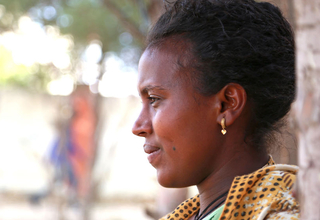Sexual violence in conflict: a hidden crisis
Conflict is on the rise. We see the images everywhere. Online and in the news. Sometimes even in our own communities. Soldiers with guns run in front of shattered buildings, along streets strewn with debris and the remains of human lives.
Rarely seen, however, is one of the most horrific forms of violence in conflict – that perpetrated on the bodies of women and girls. Rape, sexual assault, forced marriage, sexual slavery and other forms of gender-based violence run rampant in modern wars.
UNFPA remains deeply concerned about the deplorable violence experienced mostly by women and girls, but also by men, boys and people from marginalized communities – and the fact that most cases go unreported and unpunished. Perpetrators act with impunity, flagrantly using sexual violence as a weapon of war. Terrorist groups and transnational criminal networks also turn to sexual violence to trigger panic and traumatize communities. Gender-based hate speech online incites more violence. Specific targets may include women peacebuilders and human rights defenders as well as those assisting survivors of sexual violence.
Under international law, systemic rape and other forms of sexual violence are listed as crimes against humanity and war crimes. So why is progress in stopping them so slow? The most recent report by the United Nations Secretary-General on conflict-related sexual violence found that over 70 per cent of State and non-State parties named in the report are persistent perpetrators, having committed crimes for five or more years. Every new conflict, including now in Ukraine and Sudan, brings fresh accounts of this vicious cycle starting once again.
The situation could get even worse. Some 350 million people need humanitarian assistance today, more than double the number from just three years ago. New and prolonged conflicts have driven much of the increase, putting millions more people at risk of sexual violence. Many who become victims find it difficult to access help as conflict and insecurity break down health and justice systems. Many will be too afraid or ashamed to seek care.
When will it stop? At current rates of change, the answer seems like never. That is not an answer that we can ever accept. Sexual violence destroys lives and violates human rights. It must not be “normalized” as something that is destined to happen, something that cannot be stopped.
Every person has a human right to life, liberty and security of person. People like 17-year-old Mahlet (name changed), who was raped when she fled conflict in Ethiopia. Or Rehman (name changed), who survived war in Yemen only to be married at age 15 to a man who violently abused her.
Both found assistance through life-saving services provided by UNFPA, the UN sexual and reproductive health agency, which coordinates the response to gender-based violence in over 30 emergency contexts. This is a powerful network of thousands of local responders and community actors who are engaged in ending sexual violence through prevention, outreach and risk mitigation.
On the International Day for the Elimination of Sexual Violence Conflict, we call on the global community to vastly scale up action and funding to respond to these growing needs. Of the funds required to prevent and address gender-based violence in crisis settings in 2023, only 5 per cent has been received.
We must work together to end this horror, not allow it to endlessly repeat.




